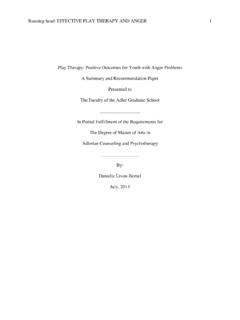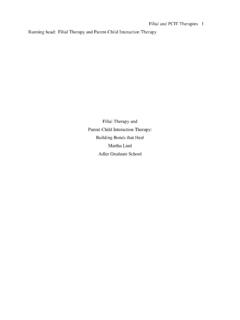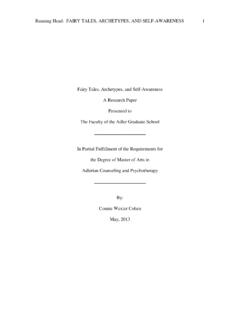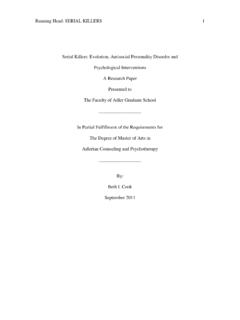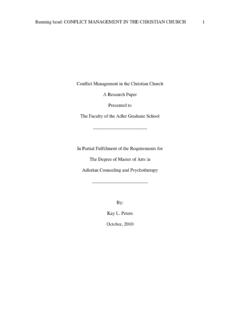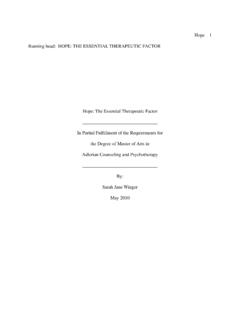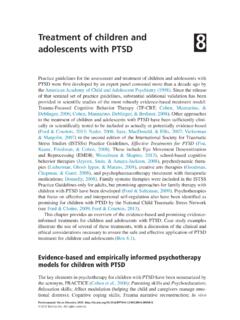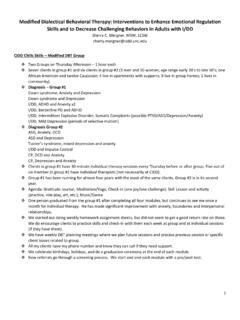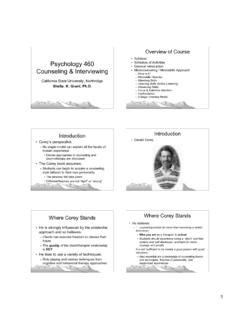Transcription of Reactive Attachment Disorder - Adler Graduate School
1 Reactive Attachment Disorder In Partial Fulfillment of the Requirements for the Degree of Master of Arts in Marriage and Family therapy Presented By: Renae Frederick Facts about Reactive Attachment Disorder Attachment is a term used as a strong emotional bond that develops between children and their caregiver. Reactive Attachment Disorder otherwise known as (RAD) is a mental health Disorder in which the child is unable to form healthy relationships, particularly with their primary caregiver. Many children with RAD have been physically or emotionally abused or neglected. RAD is commonly seen with children who have experienced a form of trauma before the age of 5.
2 (Hardy, 2007) Facts about Reactive Attachment Disorder Maltreatment such as abuse or neglect may compromise development and cause social, cognitive, emotional, and behavioral problems as the child grows. It is thought to result from a lack of consistent care and nurturing in early years. Reactive Attachment Disorder Some children with RAD have experienced inadequate care in an institutional setting, or other out-of-home placement such as residential programs, foster care or orphanages. Attachment Disorder may impact the way one views themselves and future relationships. (Nichols, M., Lacher, D.)
3 , & May, J. 2010) DSM-IV-TR and Reactive Attachment Disorder According to the DSM-IV-TR there are 2 different types of presentation to Reactive Attachment Disorder . Inhibited Type is characterized by a predominate failure to initiate and respond to most social interaction in a developmentally appropriate way for their age. Disinhibted Type is characterized by a pattern of diffuse Attachment . The child shows indiscriminate sociability or lack of selectivity in their choices of Attachment figure. Reactive Attachment Disorder of Infancy or Early Childhood Please see handout provided DSM Diagnostic Criteria Characteristics of Inhibited Type RAD Inhibited Type RAD is also referred to as Ambivalent.
4 Children can present but are not limited to the following: Will push affection away to keep control Are angry, defiant and can be violent Destructive both with their own belongings and others Difficult children to parent because they sabotage or destroy almost everything positive that happens to them Manipulative When they want something they act very affectionate (Hardy, 2007) Additional Characteristics of Inhibited Type RAD Have few friends if any, although they will say they do, listing several acquaintances Lack the ability to give and receive love Lack empathy for others Poor impulse control Lying for no apparent reason Developmental /learning delays Problems with food.
5 Either hoarding or refusing to eat Characteristics of Disinhibited Type of RAD Children can present but are not limited to the following: Tend to be overly clingy, showing extreme separation anxiety when separated from their caretaker Appear to be eager to please and are superficially compliant Lack an understanding of social boundaries, often in others personal space Attention seeking Chronic anxious appearance Exaggeration of needs for assistance Can be perceived as shallow (Hardy, 2007) Are often passive aggressive. Constantly doing little things wrong, but never doing anything really bad.
6 These children have a higher risk to go off with strangers because they fail to distinguish between people that want to help them and people that want to harm them. Poor Impulse control Characteristics of Disinhibited Type of RAD Differential Diagnosis It is important to distinguish RAD from other diagnosis with related symptoms because effective treatment for RAD and other disorders can be quite different. Conduct Disorder (CD) Some children with RAD and many with Conduct Disorder exhibit aggressive behavior, have frequent temper outbursts and are often rejected by peers and adults. The difference between RAD and CD- Children with CD are able to form some satisfying relationships with peers and adults.
7 Children with RAD have a pervasive inability to developmentally form appropriate relationships with others. (Alston, 2000; Wilson, 2001) Differential Diagnosis Depression- Children with Inhibited type of RAD are often withdrawn in the same way that depressed children are. The difference between RAD and Depression- Depressed children are often able to form appropriate social relations with those who reach out to them, whereas children with RAD seldom have the ability. (Alston, 2000; Wilson, 2001) Obstacles in Recognizing Reactive Attachment Disorder General lack of familiarity with Disorder by clinicians Relatively new diagnosis Misunderstood by clinicians RAD shares many symptoms with disorders that are common among children.
8 The existence of co-occurring disorders is likely to increase the complexity required for effective treatment. (Alston, 2000; Wilson, 2001) Assessment Currently there is no specific validated tool for diagnosing Reactive Attachment Disorder Diagnosis is made on the basis of the following: Diagnostic Interview History and Behavioral Observations Medical and Psychiatric examinations- Rule out physical causes or differential mental and medical illness diagnoses Interview the child s caregiver- obtain history of maltreatment and Attachment disordered behaviors. (Boekamp, 2008) Treatment Modalities for Children & Caregivers There are two common approaches to treating families with Attachment problems.
9 The first is psycho educational treatment focused on increasing the caregivers knowledge on development, self- care and relationship building. The second is psychotherapy with the caregiver and child, focusing specifically on the Attachment relationship and dysfunctional internal representation. It is recommended that the clinician take on the role of a coach to the caregiver. Not modeling but simply teaching practical information then helping the caregiver implement it. Loving and capable caregivers provide the core of what is needed to help children with Reactive Attachment Disorder . It is necessary for affected children to recover by being offered plentiful opportunities for recovery.
10 Treatment Modalities for Children & Caregivers For years play therapy has been a well-established and popular mode of child treatment in clinical practice. Play therapy is a method of psychotherapy in which the therapist uses the child s fantasies and symbolic meaning of his or her play as a medium for understanding and communication. One reason Play therapy has proven to be a particularly useful approach with children is that they have not yet developed abstract reasoning abilities and verbal skills needed to adequately articulate their feelings, thoughts and behavior. For children toys are their words and play is their conversation.
